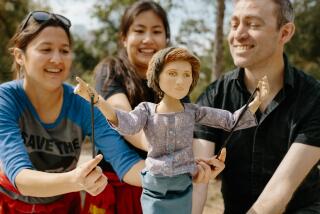Review: Jonathan Borofsky’s ‘Ballerina Clown’ in Venice dances again

Jonathan Borofsky’s colossal sculpture “Ballerina Clown” celebrates its 25th anniversary this year. Although one of the great works of public art in Los Angeles, it has been effectively out-of-commission for most of that time.
Standing above the entrance to a drug store in a mixed use, residential and commercial building at the corner of Main Street and Rose Avenue in Venice, the 30-foot-tall figure was commissioned by developer Harlan Lee. Since ballerinas and clowns both perform, it was motorized so that its right leg would perpetually kick.
But tenant complaints were lodged about mechanical noise. “Ballerina Clown” had the plug unceremoniously pulled not long after it was erected in 1989. It hadn’t moved since -- until this week.
The dancer is dancing again. According to Lee, he spent much of the past year repairing the problem and getting approvals in anticipation of the anniversary. Plans are for the sculpture to operate daily and be shut off overnight.
“Ballerina Clown” was controversial when first constructed, as happens to much public art. Now the wonderfully eccentric sculpture is a Venice landmark. (It’s up the street from another one -- the giant 1991 “Binoculars” by Claes Oldenburg and Coosje van Bruggen, which forms a marvelous triumphal arch at the entrance to a building designed by Frank Gehry.)
The sculpture is a kind of veiled self-portrait of Borofsky. For the commission, he was an accomplished artist now asked to “perform” in public, not unlike the street performers on the nearby boardwalk. He took the sculpture’s cue from the area.
A tutu-clad ballerina, emblem of refined high-art performance, is dressed in the sad-clown mask of an Emmett Kelly-style circus clown. A soap-box pedestal, spotlighted theater curtain and clumsy, oversized hands complete the ensemble.
The red-white-and-blue colossus, simultaneously male and female, is also a monumental image of an American dilemma. General civic hostility to art is common, while tensions between high and low are rife.
For an artist working in public, the risk of making an object of ridicule is real. The weirdly poignant “Ballerina Clown” has endured it, and now it’s time to dance.
Venice Renaissance, northwest corner of Main Street and Rose Avenue, Venice. Daily.
More to Read
The biggest entertainment stories
Get our big stories about Hollywood, film, television, music, arts, culture and more right in your inbox as soon as they publish.
You may occasionally receive promotional content from the Los Angeles Times.







